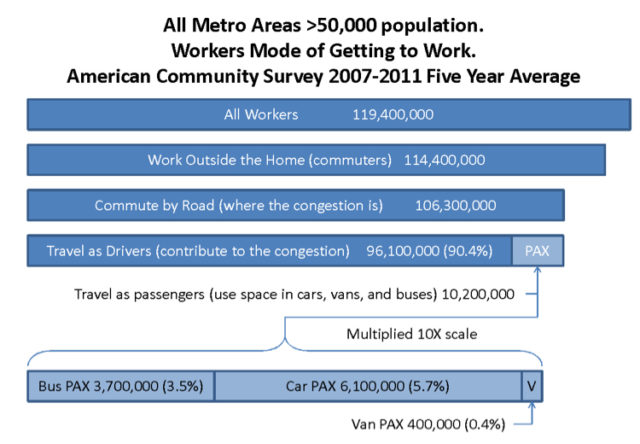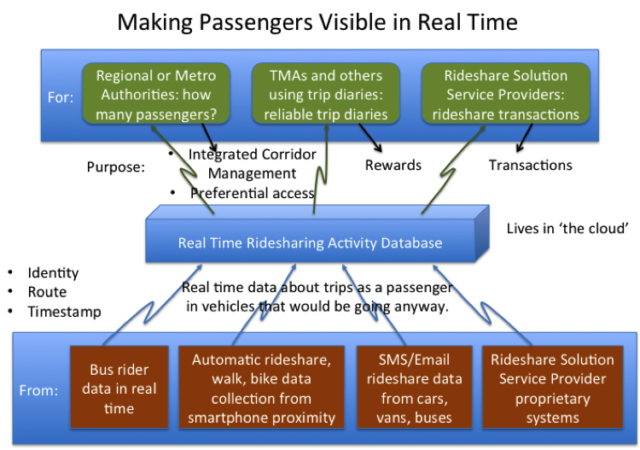
How Travelers Can Help Manage Transportation in Metro Corridors
juillet 17, 2014 — Uncategorized
Travelers are doing a lousy job at assisting in successful traffic management, often absolving responsibility to others. We need to encourage travelers to take up responsibility, and provide them with the information and tools required to do so.
We travelers have been doing a lousy job in terms of our contribution to the successful management of the road system and a phenomenal job contributing to oversubscribing it. Even though day in and day out we arrive to find the roads full, we just keep on arriving. While some of us leave home earlier every year, others do not, nor do we look to alternatives. We grumble, but in the end accept the early starts or trips that take twice as long, or more, than they ought to take.
Across the USA, in cities of over 50,000 people, 90.4% of road-based commuters travel to work as drivers. Only 9.6% of us are traveling as passengers: about 3.5% in buses and 6.1% in car and vanpools (see Figure 1).

Over 90% of us set out each day driving our private vehicle, behaving rationally even if people think we are not. Here is how we are rational:
1. We leave home according to our own schedule in a vehicle that is ready to go when we are;
2. As we leave home, we take with us the means of our return on similarly convenient terms;
3. As we leave home, we travel with hope that today will be the day that there is magically less traffic than usual, and there will be a perfect parking space waiting for us.
4. While the total cost of owning and operating a car does indeed average over 50 cents per mile over its lifetime, we do not think about the sunk costs. If the tank is full, we might see only the cost of parking as the cost of the trip.
5. If our employers provide us with free parking, or charge us for parking at a fixed monthly rate, we don’t see parking as a cost of the trip either.
6. When we consider taking transit we see: overcrowded buses or suspiciously empty ones; a huge complexity of chained bus trips; high potential for missed connections; a risk of being stranded and unable to get home.
7. We see carpooling or vanpooling as a potential straitjacket that removes our flexibility to change our plans without worrying about other peoples’ needs.
We travelers generally think that the best answer to traffic congestion is expanding the number of lanes or adding more public transport so there will be more room for all of us. This might be because when transportation planners ask for our input they generally offer us two boxes: one says expand roads, the other says add public transport. We tick both boxes, and hope. We hope other people will take public transport so we can keep driving.
We let this be someone else’s responsibility: the politicians, the engineers, or both. Sure, we spend an extra hour or more each day away from our loved ones, but it seems unavoidable. But if we were to think deeply about these two choices, what might come to mind is the old adage that the thinking that got us into this mess is not likely to get us out of it. While transportation planners and politicians develop ever-more expensive road and public transport solutions, they don’t do enough to discourage us from using the roads in the same way we did when there was ample capacity.
Here are some suggestions to transportation authorities for ways to get us travelers to participate more in efforts to manage corridors. We think the goal should be to get people and goods to their destinations, at the time they want to get there, without wasting time, resources, and our carbon budget, in stop-and-go (bad) traffic.
1. Calculate the capacity of the road in logical segments (that travelers can understand) and develop a way of measuring what percentage of capacity is being used at any point in time.
2. Set a target for managing that capacity. Some allocation should be made for freight and services. The target should be to eliminate bad traffic, with an added margin to ensure there is always room for some variability in volumes without tipping into stop-and-go. 85% of vehicle capacity might be an optimal target.
3. Use this information to determine the amount of reduction in vehicle counts required on a time slice basis to get traffic down to that target level on a route-by-route basis within each time slice.
4. Given that there are hundreds of empty car seats for every empty public transport seat, look first for help to the people driving cars with empty seats. Work with these people to understand what is needed for them to:
a) Increase the rate at which they choose to be passengers
b) Increase the rate at which they offer rides to other people
The goal should be to manage not only demand, but also latent demand, so that the reduction in bad traffic is sustained.
A logical approach would be to get the community of users (that is, travelers and freight and services people) to assume some responsibility for achieving the target. Travelers are not usually engaged in this way, except during bus strikes and Carmageddon. (Improvement work for the freeways in Los Angeles in 2011 and 2012 was expected to cause chaos, dubbed ‘Carmageddon’. Chaos did not occur.)
As an example, if all current drivers left their car at home one day per week (by becoming passengers), there would be a 20% reduction in traffic volumes, and elimination of bad traffic in many places. While figuring out how to encourage drivers to help achieve the target, here are several ideas managers of the transportation system could work with to encourage people to become passengers a larger portion of the time.
Policy Changes or Clarification
1. Charge daily for employment-location parking. To make sure it is fair, require all employers to add a fair value to salaries in lieu of free parking, and charge for parking at a market rate on the days it is used.
2. Make it clear that if we give people rides on our way to work, and they pay us, it is not going to be taxable income or interfere with our insurance coverage.
Recognition and Reward
- Recognize people for being good citizens when they travel as a passenger – whether on a bus or in a car or van – through publicity, prize draws, cash payment, or other benefits (such as points that can be used to pay for parking tickets or use of bike-share systems).
- Integrate the fare-paying mechanisms, including payment by passengers in carpools or vanpools, and transfers between these modes and buses and trains.
- For passengers, provide a back-up system that makes it easy for them to get home in an emergency – either by transit, or with vouchers for a taxi, or both.
Make Alternatives Work Better
6. Make it easy for citizens to get around at their destinations during the day. Bike-sharing, car-sharing, taxi systems, and frequent transit or circulatory buses are all ways to achieve this. Present them all as choices on a single mobile app.
7. Make taxis much easier to obtain, easier to pay for, and less costly – removing caps on the number of taxis and the technologies they can use.
8. Expand park-and-ride to increase accessibility to planned or casual carpools or vanpools, or transit. Establish casual carpooling meeting-places to fill up HOVs, and reward us with HOV3+ lanes and HOV3+ parking.
9. Test new ways to form carpools, to make it easier for citizens to be passengers on a dynamic basis.
10. Test new ways to help people travel to transit stations – such as demand-responsive shared shuttles or dedicated cycle and walking paths, or flexible carpooling solutions.
11. For the times we take transit, make sure the connections work so that we do not get stranded, or provide reliable back-up systems.
12. Make passengers visible as big data, as shown in Figure 2, so that daily levels can be measured and reported.
13. Communicate honestly and give us travelers timely feedback. Don’t be afraid to ask us to help. Just be prepared to recognize us in an appropriate way for the help we give.
Conclusion
Travelers jam the roads. This wastes time and energy, pollutes the atmosphere, damages health and has other negative externalities. This paper puts forward the idea that travelers might help manage traffic demand in corridors if the goal was for people and goods to reach their destination on time while preventing bad traffic from occurring, and if a) traveler behavior was appropriately understood, b) parking and taxation policy encouraged change, c) there was sufficient recognition and reward, d) the alternatives to driving worked better, and e) there was appropriate communication so travelers are better informed. The massive capacity of empty seats in private cars should be the first port of call for changing total throughput.
